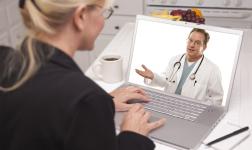
AUSTRALIA lacks nationally consistent telehealth clinical standards as its rollout gathers pace and new business models enter the field, say leading telehealth proponents.
Rural GP Dr Ewen McPhee, chair of Queensland Health’s Telehealth Advisory Committee, said a lot of work had been devoted to developing telehealth standards, but Australia still lacked a consistent, national framework for clinical governance.
“There are so many players who want to be a part of this space, but the issues around clinical safety, confidentiality and consent are all in a state of flux in Australia”, Dr McPhee told MJA InSight.
“It’s such that people don’t quite know what they are consenting to and what the implications are in telehealth and home monitoring. We certainly don’t explain it well”, said Dr McPhee, who has successfully integrated telehealth into his practice in Emerald, Queensland.
His comments came as the American College of Physicians released a position paper last week outlining an overall approach to the development of telemedicine in the US. (1)
The 13-point position statement aims to help balance the benefits of telemedicine against the risks to patients.
An accompanying editorial noted that: “The innovation that telemedicine promises is not just doing the same thing remotely that used to be done face to face but awakening us to the many things that we thought required face-to-face contact but actually do not”. (2)
Dr McPhee said his practice’s telehealth model had developed around existing clinical relationships with medical consultants, which had provided a “safety net”. However, he said as services began to offer consultations with specialists the treating GP did not know, issues with clinical governance might come to the fore.
“The most important thing about referrals is good clinical handover”, Dr McPhee said. “It’s not just about … the convenience of it all — it’s asking, has this actually improved the care of this person? Has there been a positive outcome from this event, or is it just another way of promoting a business model?
“We need to think more deeply into how we implement telehealth. We need to think about the evidence for what works and what doesn’t.”
Dr Victoria Wade, clinical director of Adelaide Unicare e-Health and Telehealth Unit, agreed that Australia had failed to develop nationally consistent models of telehealth care.
“About 30% of the population might live in a telehealth-eligible area, but the number of telehealth consultations is way under what it potentially could be”, said Dr Wade, who is also a research fellow at the University of Adelaide.
She said there had been steady growth in the uptake of telehealth, but overall use remained low. Medicare Benefits Schedule-rebated telehealth specialist consultations had increased in the past three financial years — 46 389 (2012?2013), 67 108 (2013?2014) and 84 390 (2014?2015).
Dr Wade said some successful telehealth models had been developed at local and state levels — such as the Australian College of Rural and Remote Medicine’s Tele-Derm model, and the Queensland Telepaediatric Service — but the lack of national models of care hindered the effective and widespread implementation of telehealth. (3), (4)
“It’s different in every jurisdiction because they have all been started by enthusiasts”, she said.
Efforts to develop guidelines and frameworks had trailed off due to a lack of funding, said Dr Wade, who was involved in the development of telehealth guidelines for ACRRM and other colleges. (5)
“The Commonwealth really abandoned its responsibility”, Dr Wade said. “It had the opportunity to develop a national approach to this and it didn’t, it just gave project funding to a lot of different people and then wandered off.”
Australia was also seeing the rise of “Uber” models of telehealth, she said, referring to the Uber rideshare service, where banks of specialists were made available nationally for one-off telehealth consultations.
This model was not well suited to some specialties such as psychiatry, where the development of a doctor–patient relationship and knowledge of local health services was essential.
Dr Wade said the next wave of telehealth — mobile health and health apps for home monitoring — was moving quickly and was promising, but researchers were struggling to evaluate the effectiveness of the many apps being released.
“We need more research on what apps actually work, but the field is developing so quickly, it’s difficult for the research to catch up”, she said.
(Photo: Andy Dean Photography / shutterstock)
